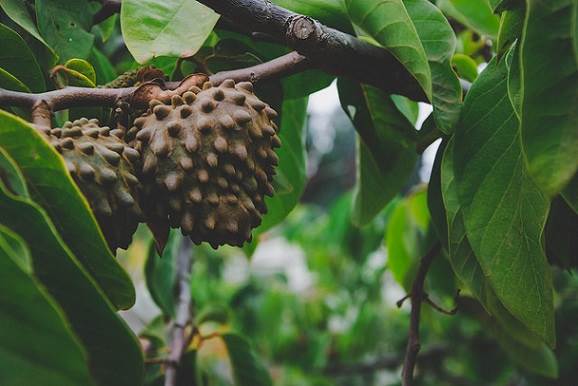Never judge a fruit by its peel. That’s the lesson I’ve learned in Peru. Case in point: the chirimoya. Mark Twain called it “the most delicious fruit known to men” and like many things Twain wrote, I may just have to agree.
I’ll never forget the first time I laid eyes on it: oval in shape, smooth to touch and bright green in color, it looks like something one of Khaleesi’s dragons surely would hatch from. This piqued my interest and my subsequent purchase. When I cut open the soft shell encased in reptile-like skin, I was surprised a fire-breathing creature didn’t fly out. Instead what was inside this exotic produce from the Andes was a white, fleshy and sweet fruit reminiscent of sherbet.

Some call it custard apple due to its creamy texture, while others prefer the name ice cream fruit because they chill it, halve it and eat it with a spoon. Whatever the name, this gift from Pachamama (Mother Earth) is one to be tried while visiting Peru.
I find this to be true for most of the wild and wondrous fruits lining the shelves of Peru’s many open-air markets and growing freely on its organic farms.
One fruit that may really may have come from fire-breathing, high-flying creatures is the dragon fruit, known as pitahaya in Peru. This cactus fruit is a vibrant yellow or pink on the outside and a pale pink or white on the inside with tiny black seeds. Aficionados say it’s subtly sweet with a refreshing flavor of kiwi and melon.
Camu camu‘s may be small, but this plum-size fruit packs a punch. Native to the Amazon, camu camu boast 60 times more vitamin C per serving than an orange. This powerful fruit also comes in powder form with one teaspoon giving you 1,180 times your recommended daily intake of vitamin C. Take that cold and flu season!
Tuna may be the chicken of the sea, but in Peru it’s also the fruit of a cactus. The Wari, Chimu and Incas cultivated this prickly pear and used its bright reddish purple flesh to die textiles. Nowadays people enjoy the juicy, welter melon flavored fruit raw and in jams and juices.
To get to the alien-like pods within a granadilla, you must crack open the outside just like an eggshell. While it may sound strange, each of the sweet and sour seeds inside is full of flavor.
In Peru, chocolate quite literally grows on trees. While cacao seeds are used to make what eventually becomes chocolate, the fruit around those seeds is edible. The white pulp of both cacao, and sister fruit copoazu, is tender and fragrant and tastes like a mixture of chocolate and pineapple. Eat your way around the seeds or send the fruit through a blender for a juice that’s fresh and sweet.
This wondrous nation is full of wild fruit; all you need is a sense of epicurean adventure to give your taste buds a treat.
Purchase Peruvian Produce
Whether a small town with a population of a few thousand or a large city populated by several million, central bazaars are bountiful. Just ask around and you will be directed to a market where you can buy fruits of all colors, shapes and sizes.
In Lima, head to Surquillo Market (Mercado Surquillo No. 1) to be a part of an authentic marketing experience. If you are short on time, try one of the chain grocery stores like Wong, Vivanda or Metro. Corner fruit stands are also plentiful.
In Cusco, try San Pedro Market to get your hands on some of the weird and wonderful fruits and vegetables native to Peru. Grocery stores like Orion carry many of the same types of produce, though with lesser variety.

